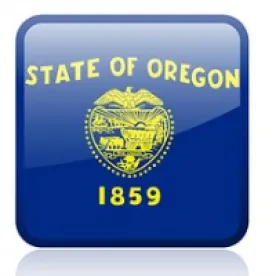Stepping in line behind Virginia and Michigan, the Oregon Occupational Safety and Health Administration (“Oregon OSHA”) issued a Temporary Rule Addressing COVID-19 Workplace Risks (“Temporary Rule”) requiring Oregon employers to take certain actions in response to potential workplace exposures to coronavirus (“COVID-19”). Some provisions of Oregon OSHA’s temporary rule go into effect on November 16, 2020 and will remain in effect until May 4, 2021, unless revised, repealed, or extended, while others come later in the year or beginning of 2021. While some requirements in Oregon OSHA’s Temporary Rule will apply to all workplaces in Oregon, the Temporary Rule also has additional requirements specific to employers with more than 10 employees and “workplaces at exceptional risk.”
COVID-19 Requirements for All Workplaces
To meet the requirements of Oregon OSHA’s Temporary Rule all workplaces must implement certain preventive measures to help prevent and minimize the potential for COVID-19 exposures and spread of the disease. These measures include:
-
Physical distancing, which entails designing work activities and workflow in a way that “eliminate[s] the need for any employee” to be within 6 feet of another unless physical distancing is not feasible.
-
Mask, face covering, or face shield requirements, which obligate employers to ensure employees and others at the workplace (e.g., vendors, patrons, contractors) wear a mask, face covering or face shield to provide source control consistent with the Oregon Health Authority’s Statewide Mask, Face Covering, and Face Shield Guidance.
-
Cleaning and sanitation efforts of all areas of the workplace under the employer’s control, with defined frequencies such as daily cleaning of the workplace when occupied for less than 12 hours or at least every 8 hours while in use if occupied for more than 12 hours a day.
-
Posting of Oregon OSHA’s “COVID-19 Hazard Poster” in a prominent location where employees will be expected to see it (e.g., safety board or employee notice board).
-
Optimization of ventilation systems no later than January 6, 2021, which requires employers evaluate existing heating, ventilation, and air conditioning (“HVAC”) systems and ensure they are designed and able to provide ventilation consistent with applicable provisions from the American National Standards (ANSI)/American Society of Heating, Refrigerating and Air-Conditioning Engineers (ASHRAE) Standards 62.1 and 62.2 (SHRAE 2019a, 2019b).
-
Completion of an exposure risk assessment by December 7, 2020, with consideration of employee feedback, site-specific concerns, and key employee exposure controls such as ability for employees to work remotely, anticipated physical distancing, impact of non-routine work activities on exposure risk, potential risks hazards created by requirement for employees to wear masks, communication of COVID-19 exposure risks and controls, effectiveness of preventive controls to prevent or minimize the spread of disease, and policies and procedures for identifying potentially sick individuals and removing them from the workplace. Employers with more than 10 employees in the state must record their COVID-19 exposure risk assessment.
-
Implementation of an Infection Control Plan by December 7, 2020, which details the required preventive controls identified in Oregon OSHA’s Temporary Rule and addresses site-specific risks determined during the exposure risk assessment. Employers with more than 10 employees in the state must ensure their Infection Control Plan is in writing.
-
Communication and training of employees on COVID-19 matters, including the employer’s compliance with Oregon OSHA’s Temporary Rule, exposure risk assessment, Infection Control Plan, and applicable COVID-19 policies and procedures.
Oregon OSHA’s Temporary Rule notably departs from guidance from the Centers for Disease Control and Prevention (“CDC”) and federal OSHA in several ways, so employers will need to be aware of the differences in preventive measure requirements. For example, Oregon OSHA allows employers to require use of face shields as a form of source control, which is contrary to current CDC guidance finding that use of face shields alone is not recommended because of ongoing concerns about their effectiveness. Oregon OSHA’s requirement on exposure risk assessments, which contemplates consideration of certain key questions and factors, will also likely be different to what is used for federal OSHA compliance. This is because federal OSHA’s concept of an exposure risk assessment focuses on pre-established levels of risk of exposure (e.g., low, moderate, high or very high), which federal OSHA has identified by whether an employee is expected to have direct or close contact with an individual who is known or suspected of having COVID-19.
Apart from prescribed preventive measures, Oregon OSHA’s Temporary Rule also requires employers establish a process for notifying employees, which contemplates notifications to (i) exposed employees who had a work-related contact with an individual who is known to have COVID-19, and (ii) affected employees who worked in the same facility or in the same “well-defined portion of the facility.” Notifications to both exposed and affected employees must also occur within 24 hours of the employer having knowledge that an individual with COVID-19 was present in the workplace. Oregon OSHA’s Temporary Rule even more directs employers to cooperate with the Oregon Health Authority with respect to COVID-19 diagnostic testing for workers and medical removals of an employee because of COVID-19 quarantine or isolation orders.
Additional COVID-19 Considerations by Industry, Workplaces With More Than 10 Employees, and Workplaces with Exceptional Risks
Along with the requirements noted above for all workplaces, Oregon OSHA’s Temporary Rule also prescribes requirements for employers in certain industries, workplaces with more than 10 employees, and workplaces with exceptional risks. If an employer is covered by one of the Temporary Rule’s industry-specific and activity-specific appendices (e.g., Retail Stores, Fitness-Related Organizations, Restaurants, and Law Enforcement) the employer must also implement the preventive measures and requirements noted in the applicable industry specific appendix. Similarly employers with more than 10 employees in the state must have written exposure risk assessments and infection control plans.
Employers operating “workplaces with exceptional risks” are identified in the Temporary Rule as those employers that require workers to perform job duties related to direct patient care, environmental decontamination in a healthcare setting, aerosol generating healthcare or postmortem procedures, direct client service in a residential care or assisted living facility, emergency response activities, personal care activities, or handle COVID-19 infected specimens or materials. These employers must provide infection control training to employees by December 21, 2020 covering these topics:
-
an explanation of Oregon OSHA’s Temporary Rule,
-
information on COVID-19 with details on mode of transmission, occupational risks of exposures, and personal risks of developing serious illness following exposure to COVID-19,
-
details on the employers exposure risk assessment,
-
explanation on requirements under the employer’s Infection Control Plan and implemented preventive measures (e.g., required use of masks, cleaning and sanitation protocols),
-
required use of masks, face shields, and personal protective equipment (“PPE”) where applicable, and
-
COVID-19 exposure control measures.
This training must be provided by someone knowledgeable in COVID-19 matters and employees’ job duties, in a manner that employees can understand and allow for discussion of questions and answers. Employers operating exceptional risk workplaces must also build additional components into their Infection Control Plan related to program responsibility and administration, with ongoing evaluation of the plan’s effectiveness and regular updates to address changes in operations or potential exposures to a hazard. Finally, Oregon OSHA’s Temporary Rule imposes additional preventive control requirements for some workplaces, including screening of all individuals entering a healthcare setting for symptoms of COVID-19, required use of barriers, partitions, and airborne infection isolation rooms where needed to protect against exposures to individuals known or suspected to be infected with COVID-19, and heightened risk ventilation requirements.
To help employers understand their obligations under the Temporary Rule, Oregon OSHA has published a chart showing the Temporary Rule’s application to different workplaces here. Oregon OSHA has also published several workplace advisory memos discussing COVID-19 requirements and is often updating its website with frequently addressed questions and answers.
Following Oregon OSHA’s issuance of the Temporary Rule, employers operating in Oregon will need to assess carefully which requirements apply to them and, at a minimum, ensure implementation of the preventive measures required for all workplaces by November 16, 2020. Employers should also know that because of slight differences between Oregon OSHA’s Temporary Rule and CDC and federal OSHA guidance, safety measures implemented in response to COVID-19 may not be uniform for all geographical locations that the employer operates in.




 />i
/>i

